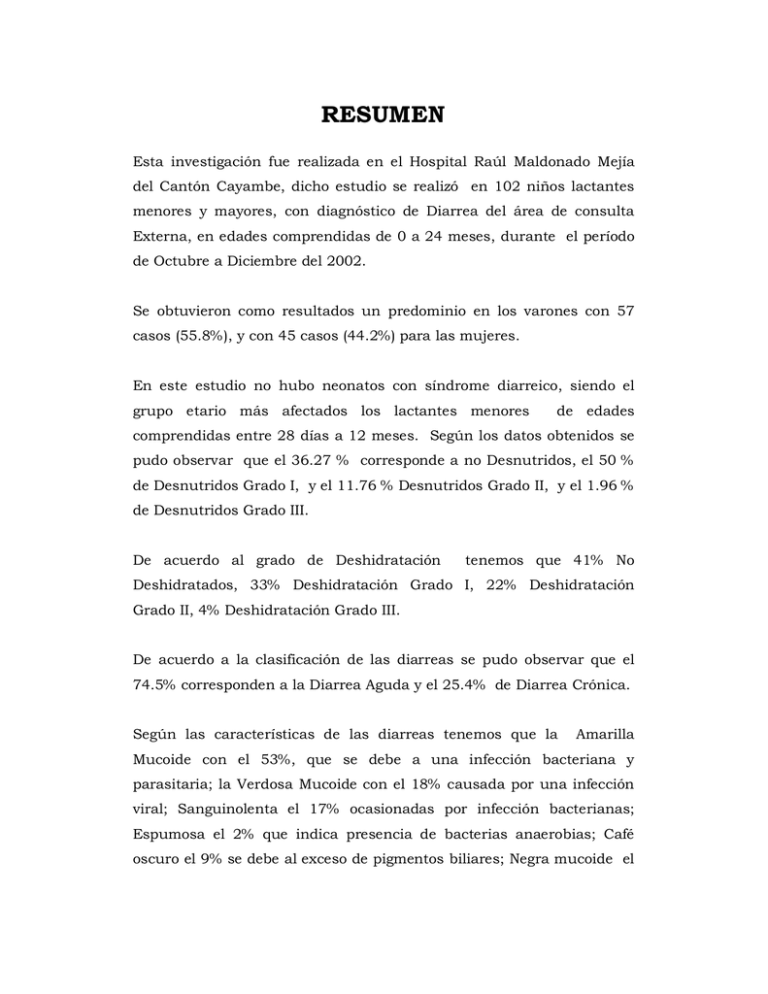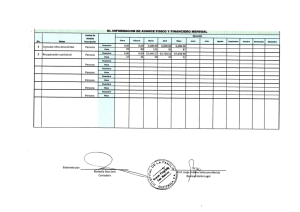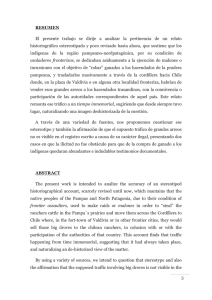RESUMEN
Anuncio

RESUMEN Esta investigación fue realizada en el Hospital Raúl Maldonado Mejía del Cantón Cayambe, dicho estudio se realizó en 102 niños lactantes menores y mayores, con diagnóstico de Diarrea del área de consulta Externa, en edades comprendidas de 0 a 24 meses, durante el período de Octubre a Diciembre del 2002. Se obtuvieron como resultados un predominio en los varones con 57 casos (55.8%), y con 45 casos (44.2%) para las mujeres. En este estudio no hubo neonatos con síndrome diarreico, siendo el grupo etario más afectados los lactantes menores de edades comprendidas entre 28 días a 12 meses. Según los datos obtenidos se pudo observar que el 36.27 % corresponde a no Desnutridos, el 50 % de Desnutridos Grado I, y el 11.76 % Desnutridos Grado II, y el 1.96 % de Desnutridos Grado III. De acuerdo al grado de Deshidratación tenemos que 41% No Deshidratados, 33% Deshidratación Grado I, 22% Deshidratación Grado II, 4% Deshidratación Grado III. De acuerdo a la clasificación de las diarreas se pudo observar que el 74.5% corresponden a la Diarrea Aguda y el 25.4% de Diarrea Crónica. Según las características de las diarreas tenemos que la Amarilla Mucoide con el 53%, que se debe a una infección bacteriana y parasitaria; la Verdosa Mucoide con el 18% causada por una infección viral; Sanguinolenta el 17% ocasionadas por infección bacterianas; Espumosa el 2% que indica presencia de bacterias anaerobias; Café oscuro el 9% se debe al exceso de pigmentos biliares; Negra mucoide el 1% que señala la ingestión de medicamentos a base de bismutos o hierro o por presencia de sangre. Los agentes etiológicos detectados con mayor frecuencia en los niños lactantes menores y mayores con síndrome diarreico fueron en primer lugar la Etiología Bacteriana con 39%, en segundo lugar la etiología Parasitaria con 40%; y por último los de etiología Viral con 21%. La sintomatología que presentaron durante este estudio fue: bajo peso y talla, vómito, fiebre, dolor abdominal, alimentación insuficiente, piel fría y húmeda, en algunos casos acompañados de diarrea con abundantes mucosidad sanguinolenta. SUMMARY This investigation was carried out in the Hospital Raúl Maldonado Mejía of the City Cayambe, this study he was carried out in 102 children smaller and bigger lactantes, with diagnosis of Diarrhea of the area of External consultation, in understood ages of 0 to 24 months, during the period of October to December of the 2002. They were obtained as results a prevalence in the males with 57 cases (55.8%), and with 45 cases (44.2%) for the women. In this study there was not neonatos with syndrome diarreico, being the group more affected etario the lactantes smaller than ages understood among 28 days to 12 months. According to the obtained data one could observe that 36.27% corresponds to not Undernourished, 50% of Undernourished Degree I, and 11.76% Undernourished Degree II, and 1.96% of Undernourished Degree III. According to the degree of Dehydration we have that 41 Not Dehydrated%, 33% Deshidratación Degree I, 22% Dehydration Degree II, 4% Dehydration Degree III. According to the classification of the diarrheas one could observe that 74.5% corresponds to the Sharp Diarrhea and 25.4% of Chronic Diarrhea. According to the characteristics of the diarrheas we have that the Yellow Mucoide with 53% that is due to a bacterial and parasitic infection; the Greenish Mucoide with 18% caused by a viral infection; Bloody 17% caused by bacterial infection; Foamy 2% that indicates presence of bacterias anaerobias; Dark coffee 9% is due to the excess of pigments biliares; Black mucoide 1% that points out the ingestion of medications with the help of bismuths or iron or for presence of blood. The agents etiológicos detected with more frequency in the children smaller and bigger lactantes with syndrome diarreico was the Bacterial Etiología in the first place with 39%, in second place the Parasitic etiología with 40%; and lastly those of Viral etiología with 21%. The sintomatología that presented during this study was: under weight and it carves, vomit, fever, abdominal pain, insufficient feeding, cold and humid skin, in some cases accompanied by diarrhea with abundant bloody mucosity.


